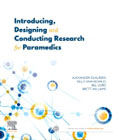
Introducing, Designing and Conducting Research for Paramedics
Olaussen, Alexander
Bowles, Kelly-Ann
Lord, Bill
Williams, Brett
The profession of paramedicine is rapidly expanding and primary research relating to prehospital interventions is exploding worldwide. This new book provides, for the first time, a meaningful and easy to understand guide to research specifically tailored for paramedics. Written by experts in research, medicine and paramedicine, Introducing, Designing and Conducting Research for Paramedics introduces the reader to the concepts of research through real-life examples. The structure follows a logical sequence from an overview of the research process to how to generate, consume and implement evidence. This book will be a valuable resource for paramedics and prehospital clinicians at any level, worldwide, who wish to contribute to the rapidly emerging body of evidence on paramedicine and understand how they can make use of this in their practice. INDICE: Section 1: Introduction to research Part One: Welcome to your research journey 1. Historical perspectives and the emergence of research in healthcare 2. The importance of research for paramedicine as a profession 3. Evidence based practice for paramedicine 4. How to use this book Part Two: Starting at the start 5. How to determine what topic to research? 6. Asking the answerable question and how to know which way to answer it 7. What to do before you start 8. Theoretical and conceptual frameworks 9. Overview of research designs and the hierarchy of evidence 10. Thinking about ethics in research Section 2: Preparing for the research Part Three: Finding what has already been done (i.e. Literature reviews / secondary research) 11. Literature reviews process and production software 12. Sourcing the available evidence (primary, secondary and tertiary evidence) 13. Appraising and critiquing the evidence (anecdotal, observational, experimental) 14. Structured reviews including Umbrella reviews, scoping reviews, rapid reviews, and narrative reviews 15. Cochrane reviews and systematic reviews (including meta-analyses and meta-synthesis) Part Four: Methodological considerations 16. Moral principles and ethical considerations 17. Data collection and storage 18. Reliability and validity in quantitative and qualitative research 19. Sampling (probability sampling/random sampling vs non-probability/non-random sampling) 20. Sample size and power calculation 21. Assessing bias 22. Cross-cultural considerations Culturally inclusive considerations in paramedic research Section 3: Explaining the what (Quantitative) Part Five: Quantitative research designs 23. Case reports and case series 24. Cross sectional studies 25. Case control studies 26. Cohort studies and registry studies 27. Randomised Controlled Trials 28. Experimental studies other than RCTs Part Six: Statistics/quantitative analysis 29. Data collection tools/approaches for quantitative research 30. Type of quantitative data (continuous, categorical, distributions, skewness) 31. Descriptive statistics, missing data, and testing assumptions 32. Statistical significance, P values, effect sizes and confidence intervals 33. Inferential statistics: t-tests, regression analysis and adjustments (Mediation versus Moderation) 34. Survival analysis Section 4: Explaining the why (Qualitative) Part Seven: Qualitative research designs 35. Phenomenology 36. Action Research 37. Case Study 38. Ethnography 39. Grounded Theory Part Eight: Qualitative analysis 40. Data collection approaches for qualitative research 41. Data collection in qualitative research 42. Types of qualitative data (quote, observations) 43. Developing themes Section 5: Other ways to answer the question Part Nine: Combining research methods and other designs 44. Mixed methodology design 45. The Delphi Technique 46. The Nominal Group Technique 47. Cost benefit/cost effectiveness research Section 6: Sharing new knowledge Part Ten: Disseminating and implementing research 48. Writing the paper (including use of tables/figures etc) 49. The implementation (translation) process 50. Presenting and getting your research published 51. Research dissemination and bibliometrics 52. Grant writing/building teams/collaboration Part Eleven: The Future of Paramedicine research, Summary and Conclusion 53. Setting up the Future of Paramedicine 54. Summary, recommendations and conclusions
- ISBN: 978-0-7295-4409-2
- Editorial: Elsevier
- Encuadernacion: Rústica
- Páginas: 300
- Fecha Publicación: 27/10/2022
- Nº Volúmenes: 1
- Idioma: Inglés
